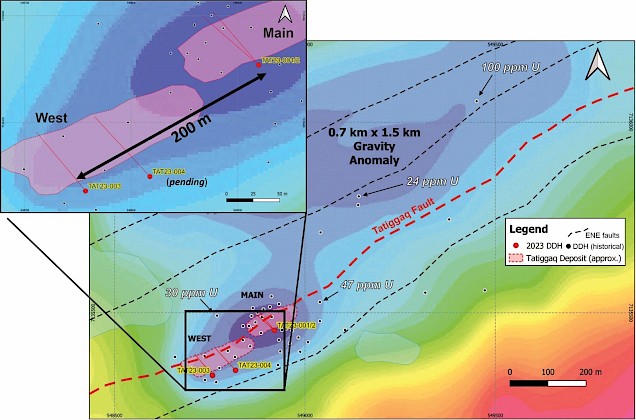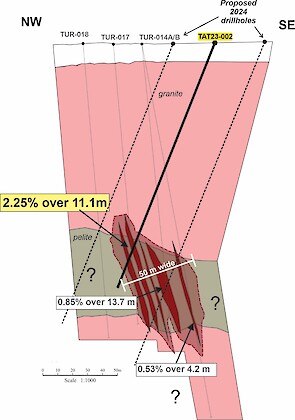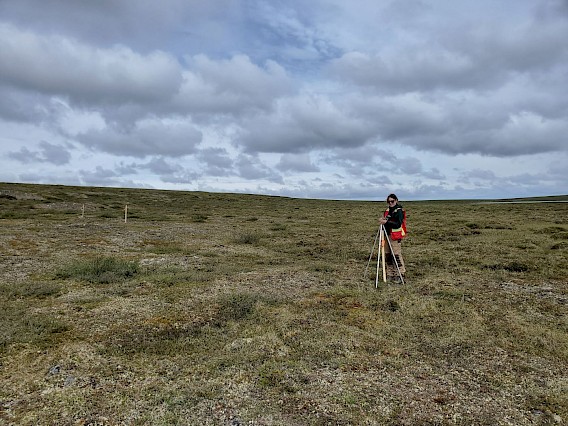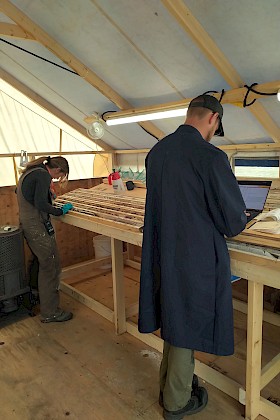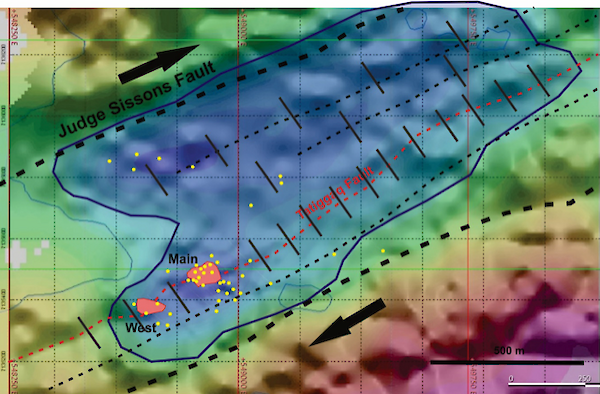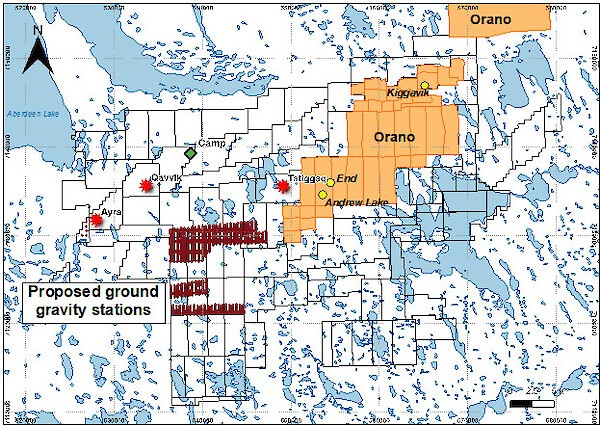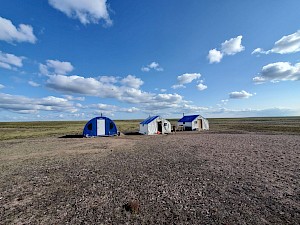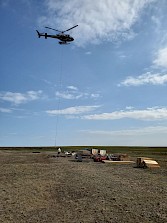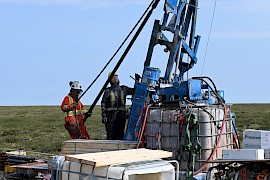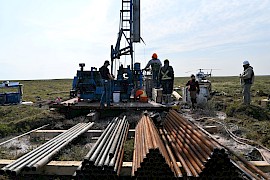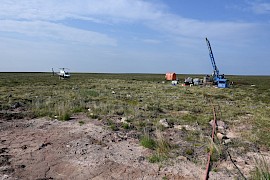| Ownership: Forum 100% |
| Stage: Highly Prospective; Significant uranium mineralization discovered by Cameco during the years 2008-2012. The claims were later abandoned due to the long period of low uranium prices from secondary supply entering the market post-Fukushima. |
| Size: 40 claims totaling 53,402 ha acquired by staking. Forum’s ground in this region now totals 95,519 ha. |
|
Location & Infrastructure: Located on the northeast edge of the Thelon Basin in Nunavut Territory, approximately 100km west of the Hamlet of Baker Lake. Baker Lake is accessible by aircraft. Chesterfield Inlet, located on the northwest coast of Hudson Bay, links Baker Lake with Hudson Bay. It also serves Agnico Eagle’s Meadowbank mine.
|
| Regional Significance: The Thelon Basin is, perhaps, the most prospective region in the world for discovering new high-grade unconformity style uranium deposits outside Saskatchewan’s Athabasca Basin. |
|
Proximity to Significant Deposits: Forum’s Aberdeen project is on-trend with the Kiggavik uranium deposit (Historic Indicated 127.3 million pound mineral resource grading 0.55% U3O8 and Historic Inferred 5.4 million pound mineral resource grading 0.33% U3O8 - (Source: Denison Mines website. See Corporate Presentation dated November 2024, p. 23, and Orano 2023 Activities Report ). Cut-off grades and other assumptions, parameters, and methods used to estimate resources are unknown. The current ownership structure is Orano Canada (66.2%), Denison Mines (16.9%), and UEX Corp (16.9%). Orano, previously known as AREVA, completed six years of engineering, environmental, and community engagement studies from 2008 to 2014 before placing the project on care and maintenance due to the prolonged period of low uranium prices.
Aberdeen project map showing 2025 drill target areas overlying residual gravity image. 2025 Summer Drill Program Underway After the merger announcement between Forum and Baseload, it was decided to proceed with a two-drill 18-25 hole program totaling ~7,000m on up to 10 unconformity and basement targets. The focus of this program is to demonstrate the potential for numerous district wide high-grade uranium mineralization along prospective fault trends and strong gravity anomalies. The accompanying map illustrates 5 unconformity targets, which include Loki, Bjorn, Thor, Squiggly River and Nymeria. In addition, 5 basement targets, which include Lobster, Tarzan, Willow, Apollo, and Starbuck, are also shown. Drilling has begun at the Loki and Bjorn sandstone unconformity targets. Sale of 2% Gross Overriding Royalty for C$1 Million In May 2025, Forum completed the sale of a 2% Gross Overriding Royalty to Uranium Royalty Corp. for C$1 million cash. Forum retains a seven-year right to repurchase 0.5% of the royalty within six months of completing a pre-feasilbility study. 2024 Summer Drill Program Completed Following the success of the 2023 program, Forum raised ~$10.3 MM in a brokered private placement, with the proceeds to be used for comprehensive follow-up exploration drilling. Between June and late September, Forum completed 6,962m of drilling in 30 holes over 5 of the more than 20 gravity targets identified to date. The first set of assay results for 11 holes drilled at Tatiggaq have been received, with 7 of the 11 holes mineralized. The mineralized strike length was increased from 200m to over 310m. Two holes tested the Qavvik target intersecting a 296m wide zone of shallow uranium mineralization wth narrow grades of up to 8.2% U3O8, further demonstrating the potential for increasing the uranium resource at Aberdeen. Significant results are as follows: 1. Tatiggaq: 11 holes focused on 2023 follow-up drilling which intersected 2.25% U3O8 over 11.1m, 1.01% U3O8 over 6.2m and 0.40% U3O8 over 12.8m.
Eight holes tested parallel structures within the 0.7 X1.5km Tatiggaq gravity anomaly. All eight holes interesected clay alteration, elevated Boron and other pathfinder minerals. More importantly, Hole TAT24-021 intersected uranium mineralization in a new area named Tatiggaq North, which represents a potential new zone located 300m north of the Main Zone.
The Tatiggaq drill interpretation summary, assay tables, geological cross-sections, and Hole TAT24-014 core photo can be reviewed in the link below. 2. Qavvik: Located 15 km west of the Tatiggaq deposit, two holes were completed to test uranium mineralization interesected by previous drilling conducted by Cameco in this 800mx800m gravity low anomaly. A 296m wide zone of shallow uranium mineralization with high grades of up to 8.2% U3O8 were intersected in a newly identified lense. Mineralization is open to the northeast and southwest. Hole QAV24-001 intersected a 296m wide zone of uranium mineralization comprising numerous discreet lenses from 36m-332m. Hole QAV24-002 intersected over 190m of discreet uranium mineralized lenses from 192m-384m.
Qavvik Target Location Qavvik 2024 Drill results. Faint dots are historical Cameco drill holes QAV24-001 Cross-section 3. Ayra, 4. Loki, 5. Ned Targets Drilling identified highly elevated uranium and boron at the sandstone/basement contact in both the Ayra and Loki targets. This finding represents the first evidence of unconformity-style uranium mineralization at the sandstone/basement contact in the Thelon Basin. Elevated uranium values as high as 72.8 ppm in the sandstone and 323 ppm in the basement at shallow depths of up to 115.2m were identified. Further evaluation of these targets will be required to determine if the Ayra and Loki grids are proximal to a uranium mineralized deposit.
Aberdeen drill camp and drilling operations (August 2024) 2023 Summer Drill Program Intersects Significant Uranium Mineralization In July-August, Forum completed five drill holes totalling 991m under the direction of Dr. Rebecca Hunter. The program focused on expanding shallow high-grade uranium mineralization at the primary Tatiggaq basement discovery and drilling the untested Ned gravity anomaly, whicn is one of several unconformity-type targets found on Forum’s 95,500 ha property.
Forum’s inaugural drill program has enabled the exploration team to gain a greter understanding of the geology. Dr. Rebecca Hunter interprets the Tatiggaq results to be significant as they demonstrate continuity of mineralization within a series of high-grade sub-parallel uranium lenses over a length of 250m. The presence of multiple sub-parallel trends within the Tatiggaq anomaly reaffims the potential for discovering new mineralization. Over 1 km of this anomaly has yet to be drill tested. Plans for follow-up drilling in 2024 are underway, which will focus on expanding mineralization along strike and at depth.
Tatiggaq Main Zone Cross Section Both the Tatiggaq Main and West Zones are interpreted to be a series of near vertical uranium bearing lenses within a fault structure that trends for 1.5 km. The width of the minteralized section has yet to be determined, but has been interpreted to be approximately 50m. Future planned drilling will help determine the true width of the zone, which is open along strike and at depth.
Forum’s Summer 2023 maiden drill program focused on the primary Tatiggaq deposit and the untested Ned target.
Geologist Dr. Rebecca Hunter spotting drill hole locations for the Aberdeen summer program
Examining drill core at the Aberdeen base camp Exploration History During the period 2008-2012, Cameco drilled 135 holes totaling ~36,000m to the west of Kiggavik and discovered two uranium deposits - Tatiggaq and Qavvik. A significant showing named Ayra was also discovered. Tatiggaq Uranium Discovery The Tatiggaq discovery, found in 2010, consists of two zones: the Main and West Zones, which average 30m in thickness at a shallow depth of 80-100m, and strike lengths of 80m and 60m respectively. Discovery Hole TUR-014A intersected 0.85% U3O8 over 13.7m and 4.03% U3O8 over 0.5m. Grades of up to 24% U3O8 over 10 -30 cm widths with average grades of approximately 1% U3O8 were reported over these two mineralized zones. The deposits remain open along strike and at depth within a large gravity anaomaly (0.8 X 1.5km) that is not fully tested.
The Tatiggaq deposit is within a large gravity anomaly that remains open along strike for 1.5km and at depth. It is a priority target for 2023. Significant intercepts include:
Qavvik Uranium Discovery The Qavvik discovery was found in 2009 and consists of four steeply lenses 5-20m wide, to a depth of 350m, over a strike length of 250m. Drill Hole DDH SAN-002 intersected four discreet mineralized intervals grading 0.92% U3O8 over 2.5m at a depth of 253.9m to 256.4m, 1.18% U3O8 over 4.3m at a depth of 259.0m to 263.3m, 0.57% U3O8 over 1.6m at a depth of 273.3m to 275.3m, and 0.62% U3O8 over 2.2m at a depth of 277.5m to 279.7m. The highest grade mineraization intersected graded 5.69% U3O8 over 0.3m. Qavvik is an early stage discovery that has never received follow-up drilling to determine the extent of mineralization in the area. The Ayra showing has all the hallmarks of classic unconformity type mineralization with uranium enrichment (67 to 610 ppm uranium) near the unconformity along steeply dipping faults that are clearly reactivated fault zones which offset the 10m to 60m thick overlying Thelon sandstone. The host rocks to the Ayra showing consist of lamprophyre, syenite, and gneiss unconformably overlain by strong altered and uranium enriched (2 to 11ppm uranium) Thelon sandstone. Only 15 widely spaced holes have tested this prospect
Cameco drilling 2008-2012 showing Tatiggaq, Qavvik, and Ayra discoveries over magnetic survey background Sources: Various Cameco reports filed with the Nunavut Mining Recorder, presentations by Cameco at the Nunavut Mining Symposium and Saskatchewan Mining Open House from 2009-2013, and Rebecca Corrine Hunter PhD Thesis, Laurentian University, Sudbur, Ontario, Canada, 2021. Summer 2022 Programs Forum’s technical team and consultants carried out the following programs:
First Photos from the Nunavut Summer 2023 Drill Program
|








 A
A